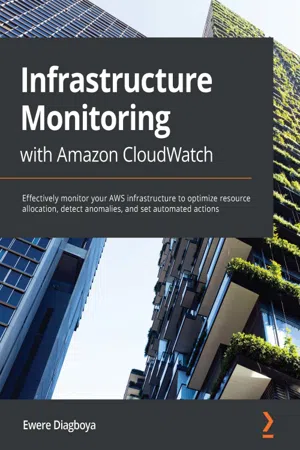
- 314 pages
- English
- ePUB (mobile friendly)
- Available on iOS & Android
Infrastructure Monitoring with Amazon CloudWatch
About This Book
Explore real-world examples of issues with systems and find ways to resolve them using Amazon CloudWatch as a monitoring serviceKey Features• Become well-versed with monitoring fundamentals such as understanding the building blocks and architecture of networking• Learn how to ensure your applications never face downtime• Get hands-on with observing serverless applications and servicesBook DescriptionCloudWatch is Amazon's monitoring and observability service, designed to help those in the IT industry who are interested in optimizing resource utilization, visualizing operational health, and eventually increasing infrastructure performance. This book helps IT administrators, DevOps engineers, network engineers, and solutions architects to make optimum use of this cloud service for effective infrastructure productivity. You'll start with a brief introduction to monitoring and Amazon CloudWatch and its core functionalities. Next, you'll get to grips with CloudWatch features and their usability. Once the book has helped you develop your foundational knowledge of CloudWatch, you'll be able to build your practical skills in monitoring and alerting various Amazon Web Services, such as EC2, EBS, RDS, ECS, EKS, DynamoDB, AWS Lambda, and ELB, with the help of real-world use cases. As you progress, you'll also learn how to use CloudWatch to detect anomalous behavior, set alarms, visualize logs and metrics, define automated actions, and rapidly troubleshoot issues. Finally, the book will take you through monitoring AWS billing and costs. By the end of this book, you'll be capable of making decisions that enhance your infrastructure performance and maintain it at its peak.What you will learn• Understand the meaning and importance of monitoring• Explore the components of a basic monitoring system• Understand the functions of CloudWatch Logs, metrics, and dashboards• Discover how to collect different types of metrics from EC2• Configure Amazon EventBridge to integrate with different AWS services• Get up to speed with the fundamentals of observability and the AWS services used for observability• Find out about the role Infrastructure As Code (IaC) plays in monitoring• Gain insights into how billing works using different CloudWatch featuresWho this book is forThis book is for developers, DevOps engineers, site reliability engineers, or any IT individual with hands-on intermediate-level experience in networking, cloud computing, and infrastructure management. A beginner-level understanding of AWS and application monitoring will also be helpful to grasp the concepts covered in the book more effectively.
Frequently asked questions
Information
Section 1: Introduction to Monitoring and Amazon CloudWatch
- Chapter 1, Introduction to Monitoring
- Chapter 2, CloudWatch Events and Alarms
- Chapter 3, CloudWatch Logs, Metrics, and Dashboards
Chapter 1: Introduction to Monitoring
- Introducing monitoring
- Discovering the types of monitoring
- Understanding the components of monitoring
- Getting to know Amazon CloudWatch
- Introducing the relationship between Amazon CloudWatch and Well-Architected
Technical requirements
Introducing monitoring

- Malted barley or sorghum is put in huge tanks and blended.
- Yeast is added to the mixture to allow the fermentation process to occur to generate alcohol.
- After fermentation, sugar is added to the mixture to sweeten it.
- The beer is stored in huge drums.
- An old bottle undergoes a mechanical process that washes and disinfects the bottle.
- The washed bottle is taken through a conveyor belt to be filled up with beer.
- After being filled up, the bottle is corked under high pressure with CO2.
- The bottle is then inserted into a crate with other bottles.
Table of contents
- Infrastructure Monitoring with Amazon CloudWatch
- Contributors
- About the author
- About the reviewer
- Preface
- Section 1: Introduction to Monitoring and Amazon CloudWatch
- Chapter 1: Introduction to Monitoring
- Chapter 2: CloudWatch Events and Alarms
- Chapter 3: CloudWatch Logs, Metrics, and Dashboards
- Section 2: AWS Services and Amazon CloudWatch
- Chapter 4: Monitoring AWS Compute Services
- Chapter 5: Setting Up Container Insights on Amazon CloudWatch
- Chapter 6: Performance Insights for Database Services
- Chapter 7: Monitoring Serverless Applications
- Chapter 8: Using CloudWatch for Maintaining Highly Available Big Data Services
- Chapter 9: Monitoring Storage Services with Amazon CloudWatch
- Chapter 10: Monitoring Network Services
- Chapter 11: Best Practices and Conclusion
- Assessments
- Other Books You May Enjoy